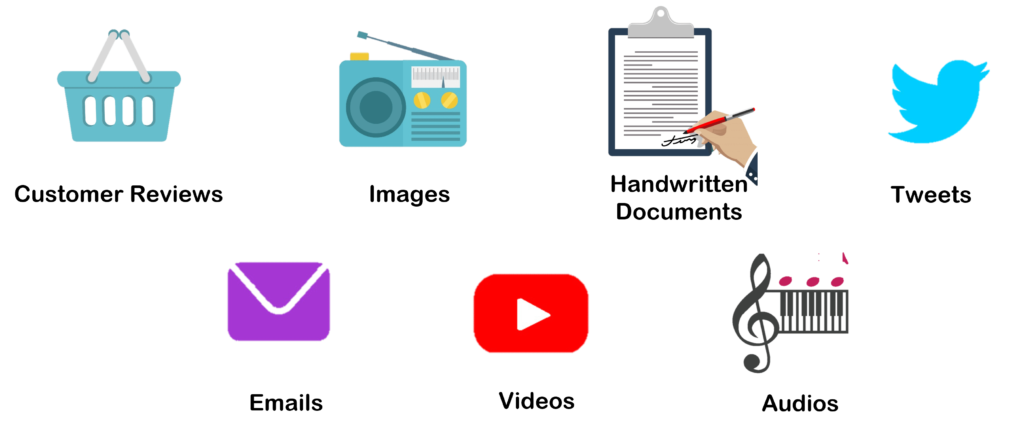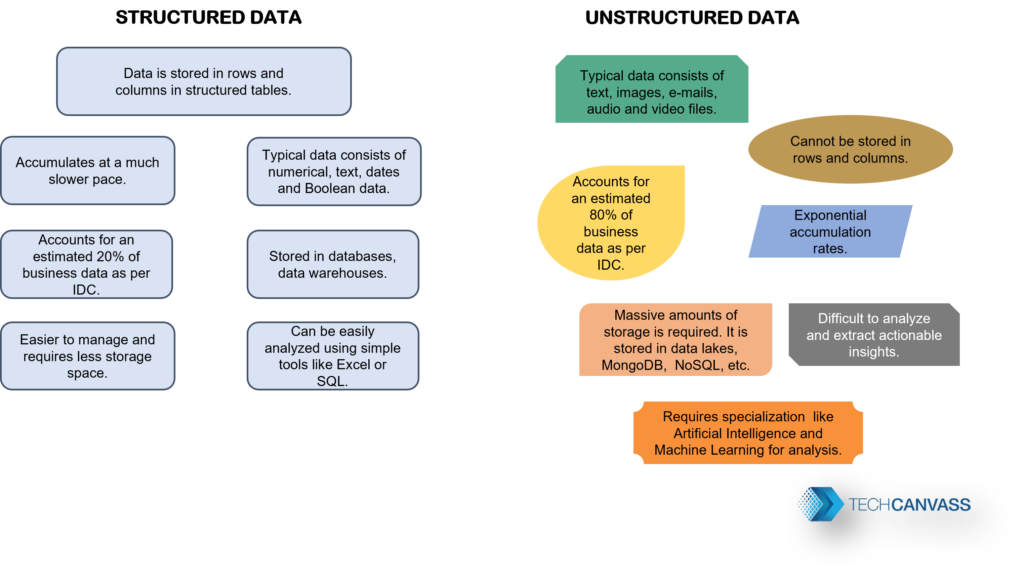
Variety in Data
IDC predicts that the Global Data sphere will grow from 33 Zettabytes (ZB) in 2018 to 175 ZB by 2025! Wow, let us try and imagine this!

Think about the different apps on your smartphone – Uber, Facebook, Instagram, Health, Siri, photos, music playlist, banking, etc. We generate enormous amounts of a variety of data every day. Businesses obtain valuable insights by analyzing various data like pdf documents, customer reviews, audio analysis, webcam video analysis, voice processing, fraud detection, etc. The list can cover pages and pages!
We will understand the different types of data that are generated: structured and unstructured and their differences.
Structured Data
Structured data is very organized with a well-defined model. You can see in the below example, that it fits nicely into rows and columns, like data in an excel. Usually, it is stored in database. You can analyze it using SQL – Structured Query Language, where we write queries to analyze the data. Non-technical users can also work easily with structured data.

Related tables like customer purchase history, watch history, product information, product inventory, etc., can be grouped in a data warehouse for marketing analysis. Let us explore some examples.
Use Cases
Employee Management: Employee attributes like name, designation, address, salary, the department can be arranged in a structured tabular format. Any changes in these attributes can be easily tracked using SQL queries. Each employee’s data can be efficiently accessed using a unique id.
Inventory Management: A retail store needs to keep accurate track of its current inventory in the warehouse for business. As new products are introduced or existing products modified, the changes must be reflected in the inventory records. This is a classic example of structured data and can be efficiently managed through a database.
Unstructured Data
Unstructured data has no definite structure or data model and is stored in its native format. Typical examples are text data, audio, video, social media data, real-time streaming data from IoT smart devices, reviews, and many more, where insights go beyond numbers to feelings, opinions, and ideas. Consider an example of customer reviews. Storing text reviews in a database will not give you any meaningful information. If the review contains a mix of text, audio, and visuals, it cannot be stored in a database. This variety and ambiguity makes it impossible for unstructured data to be forced to fit into tables. It is stored in specialized databases.

Storing massive volumes of unstructured data is challenging. Handling unstructured data is way more complicated than the structured data. The ambiguity adds to the complexity as there is no pre-defined structure to the data.
Unstructured data is stored in specialized databases like NoSQL, MongoDB, or data lakes. Given the massive scale of unstructured data generation, cloud data lakes, Hadoop, and other systems allow enormous storage and management.
Considering the variety of unstructured data formats, it is not surprising that it accounts for 80% of the total data. Unstructured data holds tremendous insights, and if not utilized, businesses will lose out on many opportunities. As per New Vantage, 97.2% of organizations are investing in big data.
Use Cases
Customer Review Analysis: To find out the sentiment (positive, negative, neutral) from customer reviews requires specialized machine learning algorithms and natural language processing. These algorithms assign a score to each word in a review, and then the overall sentiment is predicted. Expertise is needed to analyze it.
Customer Personalization: Think of the last time you accessed your Amazon page. Remember seeing the “Inspired by your shopping trends,” “Recommended items similar to your past purchases,” and “Inspired by your search history?” Amazon creates a personalized store for each customer based on their interests and previous purchasing history. Each customer’s amazon page looks different because of this personalization.
Did You Know?
Using big data, Netflix saves $1 billion per year on customer retention – Statista
A one-star increase in Yelp rating leads to a 5-9% increase in revenue – Harvard
Key Differences

To give visual clarity, the structured data points on the left side are well-arranged and have a fixed-format tiles. On the right, you can see that tiles’ shape, size, and arrangement for unstructured data have no format.
I am sure you can now confidently identify the differences between structured and unstructured data.
About Techcanvass
Techcanvass is an IT training and consulting organization. We are an IIBA Canada Endorsed education provider (EEP) and offer business analysis certification courses for professionals.
We offer CBDA certification training to help you gain expertise in Business Analytics and work as a Business Analyst in Data Science projects.
You can also learn Data visualization skills by joining our Data visualization course with Tableau and Power BI Certification Course.





